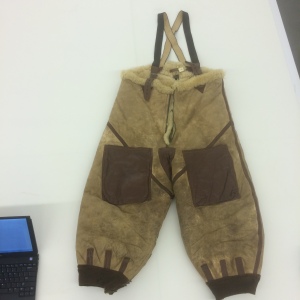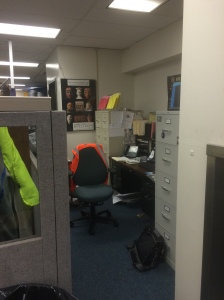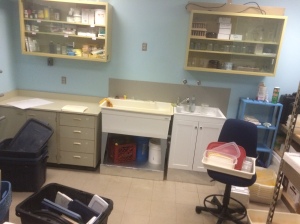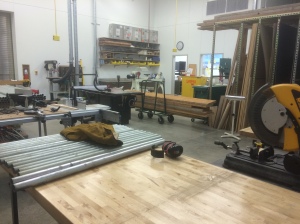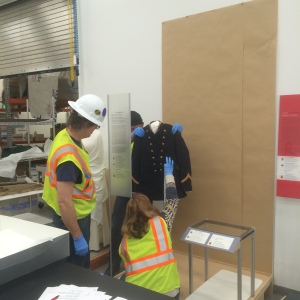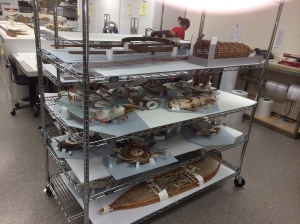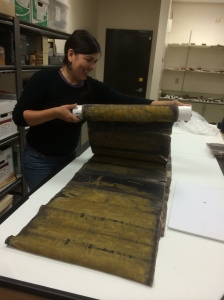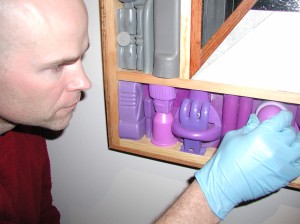Egads! This list gets later every year! And I have not posted on the blog in a full year. Time flies indeed. Here’s what’s up with me and my conservation world here in Juneau, Alaska…
1. COLLECTIONS MOVE
Construction has begun on our new storage vault for the new Alaska State Library Archives and Museum building (SLAM). They are making the storage vault first (walls are going up right now!) and we are getting ready to move all 30,000+items in the collection and on exhibit out of the building beginning March of next year. And we have only SIX WEEKS to move everything out. This is because they need to tear down our building to make way for the rest of the new structure. Our museum has a staff of only eleven people, so it is going to be an interesting operation to move everything to the new storage vault safely. To help visualize the logistics, I used my son’s Legos to create a model…

Lego model of collection move logistics
2. LAB MOVE
Did I mention they are going to bust a hole in the basement wall of the museum and create a tunnel to the new storage vault? Guess whose conservation lab is in the way? So I will be moving my lab into temporary quarters in the next few months. This lab has been here since 1976 and I have a LOT of accumulated goodness to move. Not to mention getting set up in a new temporary space for the next two or three years. The new exhibits are supposed to open in May of 2016, and of course new exhibits have lots of conservation needs. Here’s hoping the temporary lab can handle the workflow.

Shipwreck garments drying in lab
3. LOCOMOTIVE
Mining is an important part of the history of Alaska, and we were lucky to receive a donation of an original locomotive from the heyday of Juneau hard rock gold operations. It was donated by the California State Railroad Museum a few years ago. It had been significantly altered during its time with the Santa Cruz Cement Company and needs significant restoration, but will be an important part of the new exhibit galleries.

Baldwin locomotive in storage
4. LIGHTHOUSE LENS
Our 3rd order Fresnel lighthouse lens is not in bad shape, but it wil be a delicate operation to move it. Formerly located within Cape Spencer Light Station in S.E. Alaska from 1925-1974, it was made and constructed by Barbier, Bernard and Turrenne of Paris.

Large, heavy, and made of glass
5. GUTSKIN PhD
I continue to chug along on work for a PhD in anthropology, with a focus on the cultural meanings of internal organs of marine mammals. Those would include organs like stomach, intestine, bladder, and esophagus from animals like seals, walruses, and sea lions. Yup’ik, Siberian Yup’ik, Inupiaq, Alutiiq (Sugpiaq), and Aleut (Unangan) cultures all have traditions of making items like rain parkas, sails, windows, containers and drums out of these materials, but they are rarely used today and poorly understood in musuems. I am hoping to work with Native people to understand the meanings of these materials better.

Roll of bearded seal gut at Cama-i 2013
6. BETHEL
Just last week (March 21-25) I went to Bethel with my 5-year-old son, Carson, to see the Cama-i dance festival and meet the new director of the Yupiit Piciryarait Museum, Eva Malvich. I had never been to that part of the state before, and was eager to see if there might be possibilities for collaboration between our two museums as I work on the gutskin project. It was the most amazing experience to be there…the people were just wonderful and I really look forward to going back. I am heartened that people do seem interested in this kind of project, and it seems that I might have something I can give back with my knowledge of conservation and museum practices.

Yupiit Piciryarait Museum and Cultural Center in Bethel, Alaska
7. MATERIAL CULTURE
In order to begin the gutskin project, I need to write three synthesizing papers for my PhD program at the University of Alaska Fairbanks. These papers will give me some background helpful to the dissertation, and are meant to be a survey and analysis of what the anthropological literature says about certain topics I ought to develop some expertise in. The first of them for me will be about material culture. The next one will be about Alaska Native relationships with marine mammals, and the third will be about practice theory

Beautiful gutskin basket by Elaine Kingeekuk for sale in the Sheldon Jackson Museum gift shop in Sitka, Alaska
8. BASKETRY AT WOAM
After quite a long haul, I will be presenting a paper at the WOAM conference on the final results of PEG treatments on ancient baskets at the Alaska State Museum. Dana Senge and I have been working on this topic for quite some time, and will be co-authoring the paper. WOAM is the acronym for the Internation Council on Museums Conservation Committee working group on Wet Organic Archaeological Materials, and the triennial meeting is in Istanbul, Turkey this year. My husband Scott Carrlee (also a conservator) and I both had terrific experiences doing conservation fieldwork in Turkey in the 1990’s and are really looking forward to showing our son the joys and pleasures of Turkey.

Ancient spruce root basket during treatment at the Alaska State Museum
9. SHIPWRECK TREATMENTS
Hoo boy, all the above would be plenty if it were not for the twenty-odd big totes of wet shipwreck materials awaiting treatment in off site storage. They froze solid last fall while I was in Fairbanks (leave of absence to take coursework for the PhD) and are just now beginning to thaw. I have thawed out the five most troublesome ones, I think, and the materials are in an amazing state of preservation. The wreck was a gold rush era luxury steamship, and we have leather, textiles, ceramic, glass, rubber, tools, jewelry and more. I’ve dried out two full suits (jacket/ vest/pants) and numerous other garments, very similar to the ones in the 1902 Sears catalog. My favorite item so far is an amazing doll about 9″ tall that I believe is made of gutta percha. The doll is over 110 years old, and in remarkably good condition. I will be putting it in anoxic storage to slow the deterioration of this material.
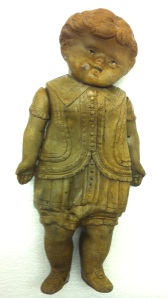
Doll, circa 1900, made of gutta percha or rubber
10. EDENSHAW ARGILLITE LOAN
Stay tuned on this one…the Alaska State Museum and its branch in Sitka, the Sheldon Jackson Museum, have loaned several important masterpieces to the Vancouver Art Gallery for a major retrospective exhibition of the argillite masterworks of Haida artist Charles Edenshaw. The descendants of the artists are involved in the exhibition and catalog, and the artworks will be accessible to many more Haida people than ever before. However, argillite is a strange material, a carbonaceous shale from a single quarry in Haida Gwaii, the homeland islands of the Haida people. The quarry no longer produces large pieces, so the number of large artifacts made from argillite are limited. Argillite is barely stone, and still retains some properties of clay, including being humidity sensitive. The ability to exapand and contract with changes in humidity is different in different directions due to the bedding plane layers of the material. When it breaks, the break edges are often crumbly. One artifact in particular, a large compote, has a diagonal fault line of quartz through its load-bearing pedestal. After a long and careful decision-making process, musuem staff decided the value of sending the artifacts to be seen by Haida people was worth the substantial risks to the artifact. I think it was the right decision, but really nerve-wracking for a conservator!

Charles Edenshaw argillite compote








 Posted by ellencarrlee
Posted by ellencarrlee 